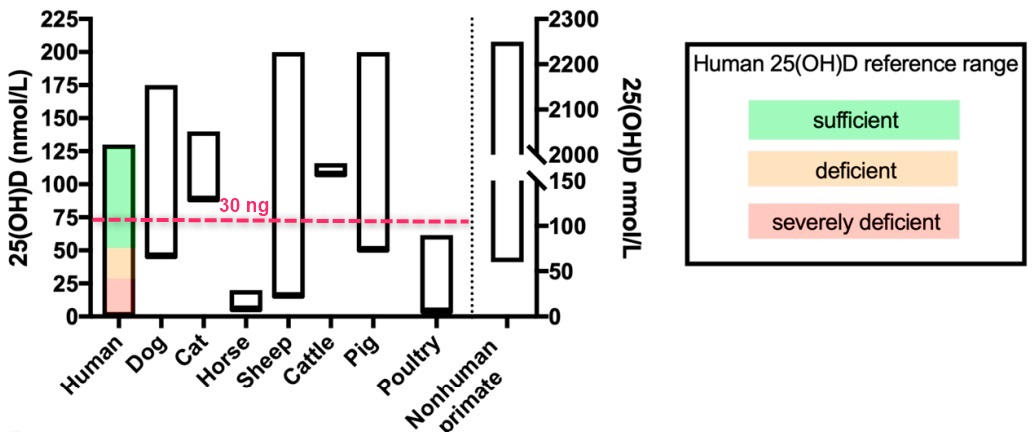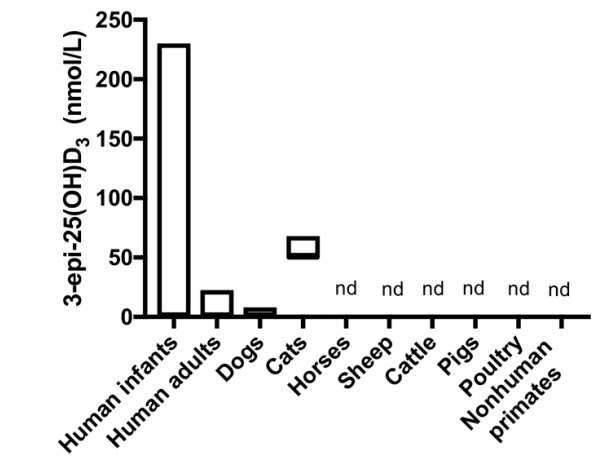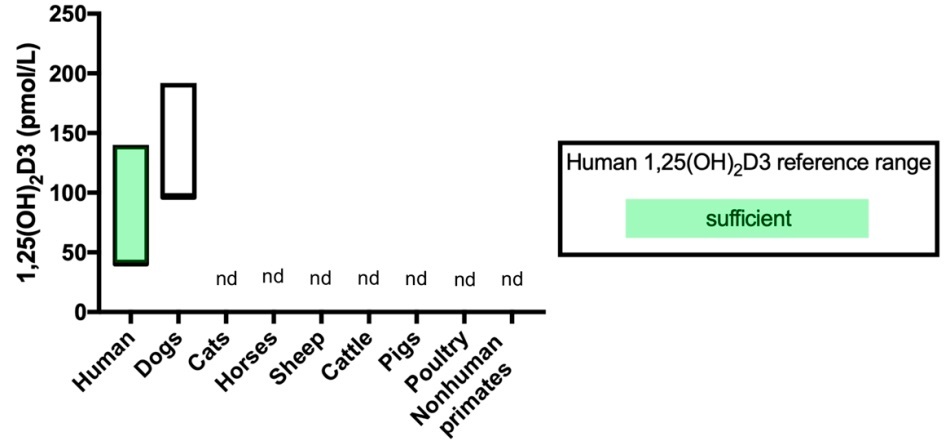Vitamin D Metabolism and Profiling in Veterinary Species
Review Metabolites. 2020 Sep 15;10(9):E371. doi: 10.3390/metabo10090371.
Overview Veterinary and vitamin D has the following
Veterinary category has 130 itemsVets give 3X vitamin D than the US govt recommends for animal OR humans
Farm Vets are paid when their "patients" are healthy,
vs doctors who are paid only when "patients" become sick
A few Vet items in Vitamin D Life
- Vitamin D types and amounts vary widely between humans and animals – Sept 2020
- Is HyD (25(OH)D) a better form of vitamin D for some animals and maybe humans with liver problems
- Rickets increasing in dogs
- Hens with Vitamin D were better in at least 5 ways – RCT Aug 2018
Cows are routinely given 30 IU per kilogram (which would be 10,000 IU for a 150 lb person)
Same information is available on Cattle need 66 IU of vitamin D per pound
The US RDA of vitamin D for cows is 13 IU per kilogram (which would be 4,300 IU for a 150 lb 'cow')
Virtually all US farmers who raise livestock use feed which is supplemented with vitamin D
Merick Vet Manual supplement if not have UV or sunlight
Parrot-like birds are given 600 IU per pound of feed
The cow experts probably base their ideas on
- what is needed,
- what actually works,
- what is cost effective (vitamin D for a cow costs about $1/year), and
- what does not have ANY long-term bad side-affects
Vet-grade Vitamin D: $50 million for the entire US population for a year.
Cow owners use really low cost vitamin D
Vitamin D costs the owner $1/cow for an entire year for a dose rate which is effectively 10,000 IU for a normal weight human.
Assuming that you want to give say 7,000 IU of vitamin D to every person in the US
And since a person weighs about 1/5 that of a cow, 7,000 IU vitamin D would be about 16 cents per year (vet grade)
Thus the cost of vet-grade vitamin D for the entire US population would be approximately
311 million * 16 cents = $50 million
Download the PDF from Vitamin D Life



The demand for vitamin D analysis in veterinary species is increasing with the growing knowledge of the extra-skeletal role vitamin D plays in health and disease. The circulating 25-hydroxyvitamin-D (25(OH)D) metabolite is used to assess vitamin D status, and the benefits of analysing other metabolites in the complex vitamin D pathway are being discovered in humans. Profiling of the vitamin D pathway by liquid chromatography tandem mass spectrometry (LC-MS/MS) facilitates simultaneous analysis of multiple metabolites in a single sample and over wide dynamic ranges, and this method is now considered the gold-standard for quantifying vitamin D metabolites. However, very few studies report using LC-MS/MS for the analysis of vitamin D metabolites in veterinary species. Given the complexity of the vitamin D pathway and the similarities in the roles of vitamin D in health and disease between humans and companion animals, there is a clear need to establish a comprehensive, reliable method for veterinary analysis that is comparable to that used in human clinical practice. In this review, we highlight the differences in vitamin D metabolism between veterinary species and the benefits of measuring vitamin D metabolites beyond 25(OH)D. Finally, we discuss the analytical challenges in profiling vitamin D in veterinary species with a focus on LC-MS/MS methods.
Vitamin D types and amounts vary widely between humans and animals – Sept 2020 199 visitors, last modified 19 Sep, 2020,
Printer Friendly PDF this page! Follow this page for updates This page is in the following categories (# of items in each category) Veterinary and Vitamin D 130 Attached files
ID Name Comment Uploaded Size Downloads 14330 1,25.jpg admin 19 Sep, 2020 11:48 52.56 Kb 47 14329 3-epi.jpg admin 19 Sep, 2020 11:48 41.56 Kb 44 14328 25(OH).jpg admin 19 Sep, 2020 11:47 84.10 Kb 46 14327 Vitamin D Metabolism in animals.pdf PDF 2020 admin 19 Sep, 2020 11:47 2.84 Mb 48
See any problem with this page? Report it (FINALLY WORKS)
Vets give 3X vitamin D than the US govt recommends for animal OR humans
Farm Vets are paid when their "patients" are healthy,
vs doctors who are paid only when "patients" become sick
A few Vet items in Vitamin D Life
- Vitamin D types and amounts vary widely between humans and animals – Sept 2020
- Is HyD (25(OH)D) a better form of vitamin D for some animals and maybe humans with liver problems
- Rickets increasing in dogs
- Hens with Vitamin D were better in at least 5 ways – RCT Aug 2018
Cows are routinely given 30 IU per kilogram (which would be 10,000 IU for a 150 lb person)
Same information is available on Cattle need 66 IU of vitamin D per pound
The US RDA of vitamin D for cows is 13 IU per kilogram (which would be 4,300 IU for a 150 lb 'cow')
Virtually all US farmers who raise livestock use feed which is supplemented with vitamin D
Merick Vet Manual supplement if not have UV or sunlight
Parrot-like birds are given 600 IU per pound of feed
The cow experts probably base their ideas on
- what is needed,
- what actually works,
- what is cost effective (vitamin D for a cow costs about $1/year), and
- what does not have ANY long-term bad side-affects
Vet-grade Vitamin D: $50 million for the entire US population for a year.
Cow owners use really low cost vitamin D
Vitamin D costs the owner $1/cow for an entire year for a dose rate which is effectively 10,000 IU for a normal weight human.
Assuming that you want to give say 7,000 IU of vitamin D to every person in the US
And since a person weighs about 1/5 that of a cow, 7,000 IU vitamin D would be about 16 cents per year (vet grade)
Thus the cost of vet-grade vitamin D for the entire US population would be approximately
311 million * 16 cents = $50 million
Download the PDF from Vitamin D Life
The demand for vitamin D analysis in veterinary species is increasing with the growing knowledge of the extra-skeletal role vitamin D plays in health and disease. The circulating 25-hydroxyvitamin-D (25(OH)D) metabolite is used to assess vitamin D status, and the benefits of analysing other metabolites in the complex vitamin D pathway are being discovered in humans. Profiling of the vitamin D pathway by liquid chromatography tandem mass spectrometry (LC-MS/MS) facilitates simultaneous analysis of multiple metabolites in a single sample and over wide dynamic ranges, and this method is now considered the gold-standard for quantifying vitamin D metabolites. However, very few studies report using LC-MS/MS for the analysis of vitamin D metabolites in veterinary species. Given the complexity of the vitamin D pathway and the similarities in the roles of vitamin D in health and disease between humans and companion animals, there is a clear need to establish a comprehensive, reliable method for veterinary analysis that is comparable to that used in human clinical practice. In this review, we highlight the differences in vitamin D metabolism between veterinary species and the benefits of measuring vitamin D metabolites beyond 25(OH)D. Finally, we discuss the analytical challenges in profiling vitamin D in veterinary species with a focus on LC-MS/MS methods.
| 199 visitors, last modified 19 Sep, 2020, |
| ID | Name | Comment | Uploaded | Size | Downloads | |
|---|---|---|---|---|---|---|
| 14330 | 1,25.jpg | admin 19 Sep, 2020 11:48 | 52.56 Kb | 47 | ||
| 14329 | 3-epi.jpg | admin 19 Sep, 2020 11:48 | 41.56 Kb | 44 | ||
| 14328 | 25(OH).jpg | admin 19 Sep, 2020 11:47 | 84.10 Kb | 46 | ||
| 14327 | Vitamin D Metabolism in animals.pdf | PDF 2020 | admin 19 Sep, 2020 11:47 | 2.84 Mb | 48 |
